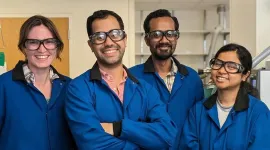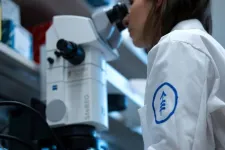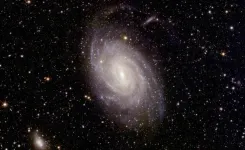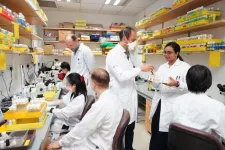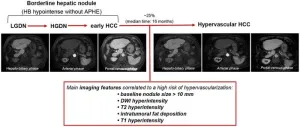(Press-News.org) Carbon dioxide is the greenhouse gas, singlehandedly responsible for 78% of the change in energy balance in Earth's atmosphere between 1990 and 2022.
A byproduct of burning fossil fuels, carbon dioxide enters the atmosphere from car exhaust and coal-fired power plants. Even some renewable energy resources produce a small amount of carbon dioxide, although at a tiny fraction of the amount coal and natural gas create.
At its core, this molecule is just an arrangement of one carbon and two oxygen atoms that can be reorganized through a process called electrochemical carbon dioxide reduction (CO2R) into clean fuels and useful chemicals. But the process is often done at a loss, with competing processes pulling the atoms in unwanted directions that create unwanted byproducts.
In a paper published today in Nature Catalysis, researchers from the UChicago Pritzker School of Molecular Engineering’s Amanchukwu Lab outlined a way to manipulate water molecules to make CO2R more efficient, with the ultimate goal of creating a clean energy loop.
Through their new method, the team was able to perform CO2R with nearly 100% efficiency under mildly acidic conditions, using either gold or zinc as catalysts.
“Imagine we can have green electricity from solar and wind, and then use this electricity to convert any carbon dioxide back into fuels,” said PME PhD candidate Reggie Gomes, first author of the new paper.
Competing with HER
Electrochemically disassembling a molecule is like the break shot in a game of pool. The previous arrangement disappears and the balls scatter across the table, coming to rest in new combinations – not always the ones the player intended.
Similarly, researchers performing CO2R use electricity and water to break up and rearrange the harmful greenhouse gas. This sends atoms of carbon and oxygen from the carbon dioxide caroming across the table with hydrogen atoms from the water.
If it works as intended, the atoms form other, more desirable molecules that can be used as fuels or chemicals.
But as the atoms scatter, stable pairings of two hydrogen atoms often form, a process called the hydrogen evolution reaction (HER). This makes CO2R less efficient, as energy and atoms that become hydrogen gas can’t be part of the molecules the scientists were trying to create.
Even in small quantities of water, CO2R is always competing with HER.
The Amanchukwu Lab – which is most notable for its battery research – applied insights from aqueous batteries to the problem, hypothesizing that controlling the water with organic solvents could provide a solution.
All that glitters
Both CO2R and HER rely on water as a proton donor. Using organic solvents and acid additives, the team was able to tune the water behavior, finding the sweet spot where it donated the right amount of protons to create the intended molecules, not the hydrogen gas and other unwanted materials like carbonates.
“In general chemistry we learn that carbon dioxide reacts with hydroxide to form carbonate. That's undesired because it depletes the molecule we want to valorize,” said Neubauer Family Assistant Professor of Molecular Engineering Chibueze Amanchukwu.
Many of the most-effective ways to perform CO2R rely on precious metals.
“Platinum, silver, gold – for research purposes, they're great catalysts,” Gomes said. “They're very stable materials. But when you're thinking about industrial applications, they become cost-prohibitive.”
By engineering the electrolyte, the new method can get similar results using cheaper, more abundant materials.
“Right now, the best way to do this electrochemically at room temperature is to use precious metals. Gold and silver can suppress the hydrogen evolution reaction a little bit,” Amanchukwu said. “Because of our discovery, we can now use an earth-abundant metal, zinc, because we now have a separate way to control water.”
The American Chemical Society’s Chemical & Engineering News recently named Amanchukwu one of its yearly Talented Twelve“young scientists who are making the world a better place through chemistry.”
Citation: “Modulating water hydrogen bonding within a non-aqueous environment controls its reactivity in electrochemical transformations,” Gomes, et al, Nature Catalysis, May 24, 2024. DOI: https://doi.org/10.1038/s41929-024-01162-z
Funding: This work was primarily supported by the U.S. Department of Energy Office of Science Basic Energy Sciences, Early Career Research Program (DE-SC0024103). Chibueze Amanchukwu was supported by the CIFAR Azrieli Global Scholars Program and Reggie Gomes was partially supported by the Roberto Rocca Fellowship Program.
END
Controlling water, transforming greenhouse gases
Scientists looking to convert carbon dioxide into clean fuels and useful chemicals often make hydrogen gas and carbonates as unwanted byproducts. A new paper from the UChicago Pritzker School of Molecular Engineering has found a cleaner path
2024-05-24
ELSE PRESS RELEASES FROM THIS DATE:
MSK Research Highlights, May 24, 2024
2024-05-24
New research from Memorial Sloan Kettering Cancer Center (MSK) investigates a promising approach against diabetic retinopathy and finds patients with early-onset colorectal cancer likely don’t need more frequent surveillance colonoscopies.
Anti-ceramide immunotherapy promising against diabetic retinopathy, animal studies suggest
Diabetic retinopathy is a condition that affects blood vessels in people with diabetes and can cause blindness. Now a new study from a team at MSK, Michigan State University, and the University of Oklahoma Health Sciences Center shows that diabetic retinopathy can be considered a “ceramidopathy” — which ...
ASCO: Large precision oncology study identifies differences in prostate cancer genomics among a racially and ethnically diverse cohort of U.S. veterans
2024-05-24
FINDINGS
A new study led by a UCLA-VA collaborative team looking at the landscape of genomic alterations in more than 5,000 veterans with metastatic prostate cancer uncovered differences in the genomic makeup of cancer cells that were associated with race and ethnicity.
Although the team found that a similar set of cancer-related genes were altered in both non-Hispanic Black and non-Hispanic white veterans, the frequencies that these alterations were observed at varied significantly ...
ASCO: Combination therapy significantly improves outcomes for patients with metastatic colorectal cancer
2024-05-24
FINDINGS
A study led by UCLA Health Jonsson Comprehensive Cancer Center researchers found that using a combination of experimental immunotherapy drugs with chemotherapy significantly improves progression-free survival and overall survival for patients with metastatic colorectal cancer who have previously undergone standard chemotherapy treatment when compared to those who received the targeted therapy regorafenib alone.
The median progression-free survival, which is the amount of time during and after treatment when the cancer does not worsen or progress, with the combination treatment was 6.2 months compared to 2.1 months for those ...
Euclid space mission releases first scientific results and new images of the cosmos
2024-05-24
European space mission Euclid has released early scientific papers based on observations made by the space telescope, along with five new astronomical images of the Universe, as the project sets about unravelling the secrets of the cosmos.
The new images are part of Euclid’s Early Release Observations (EROs) and accompany the mission’s first scientific data and 10 forthcoming science papers. Their publication comes less than a year after the space telescope’s launch and some six months after it returned its first full-colour ...
Sociodemographic heterogeneity in the associations of social isolation with mortality
2024-05-24
About The Study: Social isolation was associated with increased risks of all-cause, cardiovascular diseases, and malignant neoplasm mortality, with associations varying across populations. This study fills an important gap in research on social isolation, emphasizing its varied associations across demographic and socioeconomic groups.
Corresponding Author: To contact the corresponding author, Atsushi Nakagomi, M.D., Ph.D., email anakagomi0211@gmail.com.
To access the embargoed study: Visit our For The Media website at this link https://media.jamanetwork.com/
(doi:10.1001/jamanetworkopen.2024.13132)
Editor’s Note: Please ...
COVID-19 admission rates and changes in care quality in us hospitals
2024-05-24
About The Study: In this cross-sectional study, COVID-19 surges were associated with declines in hospital quality, highlighting the importance of identifying and implementing strategies to maintain care quality during periods of high hospital use.
Corresponding Author: To contact the corresponding author, Giacomo Meille, Ph.D., email giacomo.meille@ahrq.hhs.gov.
To access the embargoed study: Visit our For The Media website at this link https://media.jamanetwork.com/
(doi:10.1001/jamanetworkopen.2024.13127)
Editor’s Note: Please see the article for additional information, ...
Preterm and early-term delivery after heat waves in 50 US metropolitan areas
2024-05-24
About The Study: Preterm and early-term birth rates increased after heat waves, particularly among socioeconomically disadvantaged subgroups in this cohort study. Extreme heat events have implications for perinatal health.
Corresponding Author: To contact the corresponding author, Lyndsey A. Darrow, Ph.D., email ldarrow@unr.edu.
To access the embargoed study: Visit our For The Media website at this link https://media.jamanetwork.com/
(doi:10.1001/jamanetworkopen.2024.12055)
Editor’s Note: Please see the article for additional information, including other authors, author contributions and ...
Research spotlight: Virtual scribes reduced physicians’ time spent on electronic health records
2024-05-24
Lisa Rotenstein, MD, of the Department of Medicine at Brigham and Women’s Hospital, is the lead author of a new study published in JAMA Network Open, “Virtual Scribes and Physician Time Spent on Electronic Health Records.”
What question were you investigating?
We sought to understand the impact of virtual scribes (human scribes who are not physically present in the exam room with the physician and patient) on how physicians spend their time and which characteristics are associated with physicians responding best to scribes.
What methods or approach did you use?
We studied the experiences of 144 physicians across specialties treating patients ...
Duke-NUS researchers develop new light-controlled ‘off switch’ for brain cells
2024-05-24
Researchers from Duke-NUS Medical School have found that a new class of light-sensitive proteins are capable of turning off brain cells with light, offering scientists an unprecedentedly effective tool to investigate brain function. The study, recently published in Nature Communications, opens exciting new opportunities to apply optogenetics to investigate the brain activity underlying neurodegenerative and psychiatric disorders such as Parkinson’s disease and depression.
Optogenetics is a technique where specific cells are bioengineered to include light-sensitive proteins that act as switches, allowing ...
Liver lesions at risk of transformation into hepatocellular carcinoma in cirrhotic patients
2024-05-24
Hepatocellular carcinoma (HCC) represents a significant global health burden as one of the most common malignancies in individuals with chronic liver disease or cirrhosis. This malignancy evolves through a multistep process, beginning with dysplastic nodules (DNs) and early HCC, progressing to overt HCC. Recent advancements in liver imaging, particularly the use of hepatocyte-specific contrast agents, have enhanced the detection of these precursor lesions, known as borderline hepatic nodules. These nodules, especially those hypointense in the hepatobiliary phase (HBP) without arterial phase hyperenhancement (APHE), present ...
LAST 30 PRESS RELEASES:
School meals could unlock major gains for human and planetary health
Menopause hormone therapy does not appear to impact dementia risk
Signature patterns of brain activity may help predict recovery from traumatic brain injury
Dresden study uncovers new key mechanism in cancer cells
New species are now being discovered faster than ever before, study suggests
Cannabis-based products show limited short-term benefit for chronic pain, with increased risk of adverse effects
Cannabis products with more THC slightly reduce pain but cause more side effects
Clearing the brain of aging cells could aid epilepsy and reduce seizures
Brain injuries linked with potential risk of suicide, new study finds
New technique lights up where drugs go in the body, cell by cell
New study finds movement of fishing fleets can reveal shifts in marine ecosystems
Embargoed: New evidence points to potential treatment for vascular dementia
Study uncovers disrupted brain balance in alcohol dependence
Working in groups can help Republicans and Democrats agree on controversial content moderation online
Structural findings reveal how distinct GPCR ligands create different levels of activation
Anything-goes “anyons” may be at the root of surprising quantum experiments
UC review: Maximizing workplace opportunity for veterans
From generation to complex control: Metasurfaces make perfect vortex beams "within reach"
Thin-film lithium niobate-based detector: recent advances and perspectives
Exploring why some people may tend to persistently make bad choices
How cells balance their protein levels
Nirsevimab vs RSVpreF vaccine for RSV–related hospitalization in newborns
Effectiveness and impact of maternal RSV immunization and nirsevimab on medically attended RSV in US children
AI gives scientists a boost, but at the cost of too many mediocre papers
Next-generation vision model maps tree growth at sub-meter precision
Genes aren’t destiny for inherited blindness, study shows
MIT study: High-fat diets make liver cells more likely to become cancerous
Exposure to multiple fine particulate matter components and incident depression in the US Medicare population
Risk of burdensome health care spending over time in the US
Nirsevimab against hospitalizations and emergency department visits for lower respiratory tract infection in infants
[Press-News.org] Controlling water, transforming greenhouse gasesScientists looking to convert carbon dioxide into clean fuels and useful chemicals often make hydrogen gas and carbonates as unwanted byproducts. A new paper from the UChicago Pritzker School of Molecular Engineering has found a cleaner path
